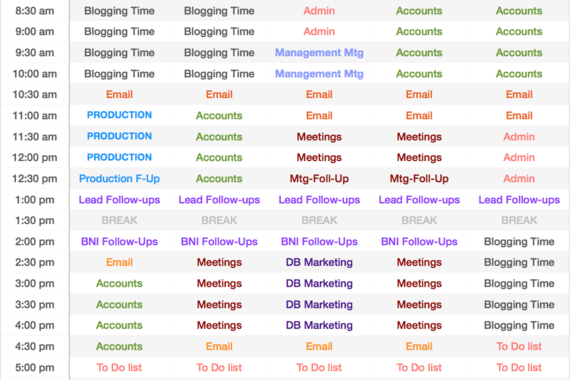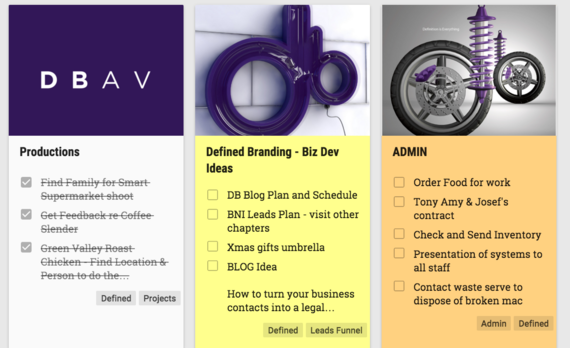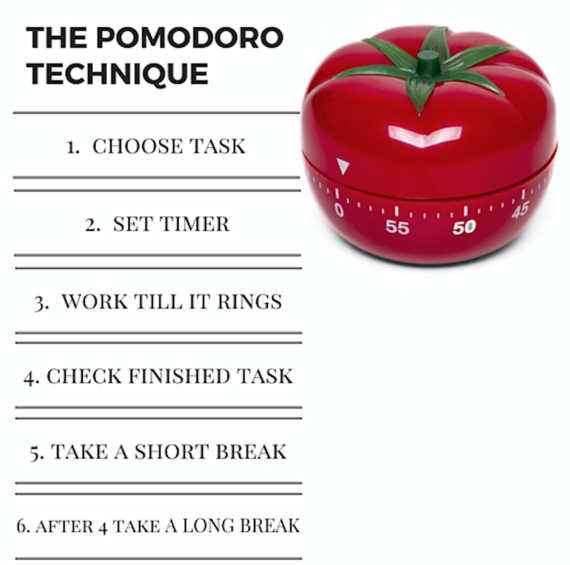If like me you've tried many systems and productivity hacks you already know there is no holy grail of productivity and that you have to find your way through the various tools and systems to create the best structure that suits your specific needs.
However the more systems we try the quicker we can find the ones what works for us personally. If you don't have much time to explore new online tools and you're always trying to improve your planning and productivity routines then this article will help you further fine tune your systems. The best tools are the ones that build strong habits.
1. Plan using time buckets
Academic research shows that one of the most effective ways of tackling productivity is by planning your week in time buckets according to your usual week load. To devise your own time bucket you need to think like you're creating a weekly breakdown of everything you do - a bit like a school time-table. The time buckets should start off looking the same every week for example 2 hours on Monday for Planning, 3 hours for writing etc.. You input this into your calendar and then make changes according to what you have booked and planned for the week. If deciding how much time to dedicate to each bucket proves to be tricky download a timer app like the chrome plugin. Time your activities for 1 or 2 weeks and then use this information to build your time buckets. Over time you may find that the time buckets don't fit your needs anymore and therefore you'll need to do this again every few months.
Thinking in time buckets will allow you to become more efficient by dedicating more time to tasks that can be clustered together. This also make it easier to stay focused and increase your speed at processing individual tasks.
2. List-Making and Google Keep
Every time bucket specified above will have a to do list attached to it. This list will grow as you empty your email inbox. In fact you should attempt to put everything on your list and out of your inbox. It is great at helping you reach and keep inbox zero.
Google keep is one of the better tools for the job especially if you're looking for a free tool. Lists can be attached to an image for visual reminders, you can share lists (which is great for delegating tasks) you have tick boxes to tick off items as you go along (and it helps motivate you too!). Its available on mobile, tablet and web so you never have to worry about forgetting, just add your to do items to the appropriate list as they pop into your head.
The great thing about Google Keep lists is that you can tag them. So for example I can have a to do list for every blog I manage and then just tag them all as client blogs. Then when my time bucket for client blogging is due I just choose the 'Client Blogs' tag in my Google Keep and all my client blog lists line themselves up neatly. Then I move on to the Pomodoro technique.
3. The Pomodoro technique
The Pomodoro technique works very well with time buckets. The technique was invented by Francesco Cirillo and is based on very simple principles. This system helps you break down your focus time into 25 minute chunks. It really helps in the long run because by thinking in Pomodoros you will improve your efficiency at predicting how much time you require for a particular task or project.
There are five basic steps to implementing the technique:
Step one - Decide what you're going to do and break it down into smaller tasks
Step Two - Set a timer to 25 minutes
Step Three - Work on the task until the timer rings (record progress tick finished tasks)
Step Four: Take a short break (3-5 minutes)
Repeat Step three and four for as long as your time bucket allows. After four Pomodoros, take a longer break (15-30 minutes). You time bucket should ideally not be longer than 4 Pomodoros - that's approximately 2 hours.
4. Planning ahead and the 4 hour work Week
Efficiency and productivity increase with clarity. If you have broken down each job into a clear steps, then you will have less space for procrastination and you are likely to take less time to achieve those tasks.
The Pomodoro technique advocates using the first few minutes to review the task breakdown. This is much simplified and faster if you have clearly planned tasks already. Spend a few minutes reviewing tasks and to do lists daily and ideally a couple of hours planning your week on Sunday evening.
If you're an early riser (and I highly recommend this one) plan your day first thing in the morning. Prepare delegation emails (without connecting to your wifi to avoid being tempted to answer any new emails that hit your inbox) and get all your planning and delegation ready before getting to the office. When you arrive at the office and plug in your wifi your emails will leave your inbox and you'll kickstart your day in seconds.
At the end of your day before leaving the office just earmark any tasks that you didn't manage or that needed more time ready to review and re-schedule in the morning.
5. Prioritise
Even the best tools will be useless if like me you find prioritising difficult. We need to accept that priorities change constantly but prioritising is what gives focus to your planning.
In order to prioritise effectively you need to assign the following to each task:
Deadline - every task needs a target date and time. If there is no external factor effecting this do it anyway. If it has no deadline it probably won't get done.
Importance - this may be based on how important this client is to your business or how quickly you can monetise a given product. Find a standard way of rating importance which is aligned with your business targets and core values and you will find that you achieve more and feel more aligned with your goals in a very short time.
When in doubt use the 80/20 rule. Is this part of the 20% that generates 80% of your revenue? If the answer is yes then its priority A. If its part of the 80 then its priority B. If it can be delegated then it's a D. The C's are nice to have's but realistically they rarely get done. It helps to have them in the mix because they will help you find time when you seem to have none going spare.
Automate - Most things can be automated. Some automation can be created easily - you can use your email marketing tool to send reminders about pending invoices. So although you may not be able to automate more complex tasks in the short term you should definitely set yourself up to automate as much of your repetitive tasks as much as possible.
Delegate - Even if you are a growing business, solopreneur or your web company pretty much runs itself there will always be tasks that keep falling in the wayside because although quite important they need doing regularly. When you see a bottleneck, outsource! - use sites like fiverr.com, find online VA's or call an ex-employee or relative. You'll find that you can stay on track more easily when this happens and dealing with different people will improve your delegation skills fast! You might find out that delegation and outsourcing actually help you increase your income so it's definitely worth a shot.
Here are some useful links to the tools mentioned:
Google Keep: http://www.Google.com/keep
The Pomodoro Technique: http://www.pomodorotechnique.com/
To help you find the motivation to rise early: Read The Miracle Morning by Hal Elrod
Images created in Canva and ReciteThis using Shutterstock tomato timer image.




